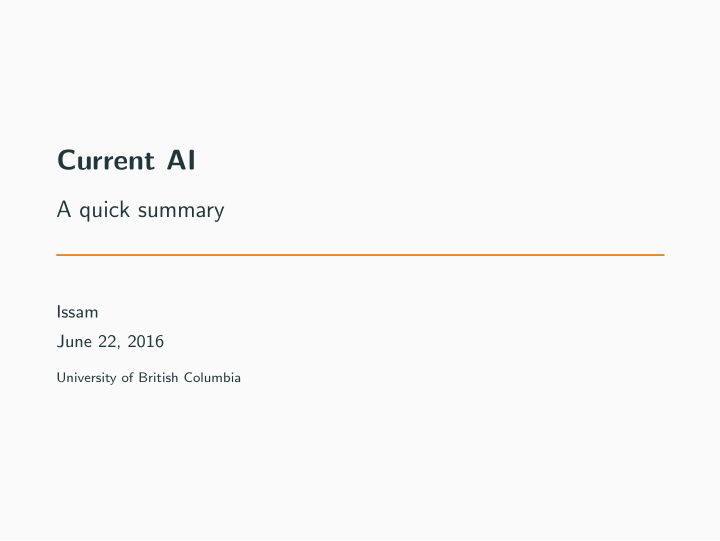



Current AI A quick summary Issam June 22, 2016 University of British Columbia
AlphaGo 1 • AlphaGo has beaten human Figure 1: Playing against human Champion Lee Sedol 4-1 • Lee Sedol is a 9 dan professional Korean Go champion who won 27 major tournaments from 2002 to 2016 1 https://en.wikipedia.org/wiki/AlphaGo 1
AlphaGo Main algorithm Figure 2: Neural Networks - trained on 30 million expert moves 2
Why wasn’t it possible in the past? Past - Neural Networks Now • It existed in 1989 • database of around 30 million moves by Go Experts • Very slow (Slow GPU and CPU) • 1202 CPUs and 176 GPUs in a distributed fashion • No database of large set of expert moves • The idea of using a neural network that learns to evaluate moves • Neural Networks was facing setbacks • Other simpler algorithms worked much faster (SVM and linear models) 3
AI Winter 2 • ALPAC (1966): Cold War, US government to auto translate russian documents and scientific reports • Aggressive support of machine translation (Noam Chomsky Grammar helped) • Very optimistic • $20 million lost, slower than human, less accurate and more costly than human based translation • this is still a challenge today! • Perceptron by Frank Rosenblatt (1969) • Thought it would be a very successful problem solver (theorem proving) • it’s a linear, basic model that can’t learn most data patterns 2 https://en.wikipedia.org/wiki/AI winter 4
AI Winter 3 • Expert systems (1990s) • Very expensive to maintain • Most are table based (No learning) • Much of the funding was cut completely except in few top universities • AI under different names (late 1990s) • Machine learning • Agents/Computational intelligence • Helped overcome the stigma of the false promises of AI • Helped procure funding 3 https://en.wikipedia.org/wiki/AI winter 5
Deep Blue 4 • chess-playing computer developed by Figure 3: Chess IBM • Beaten Kasparov 3.5 to 2.5 in 1997 • Brute force • VLSI chess chips developed for high speed (evaluates 200e6 positions per second) 4 https://en.wikipedia.org/wiki/Deep Blue (chess computer) 6
Deep Blue vs AlphaGo • Why weren’t we able to do the same Figure 4: Chess for Go ? • Evaluation function! • In chess, with consultation with pros, the following function was a great way to identify good moves • c1 * material + c2 * mobility + c3 * king safety + c4 * center control + ... • the weights, c i are tuned by hand • database of openings and endgame 7
Deep Blue vs AlphaGo • Possible moves: ≈ 10 170 for Go, ≈ 10 50 moves for Figure 5: Go Board chess • Difficult to know whether you are winning or losing • Difficult to evaluate each move • Let neural networks learn the evaluation function • 30 million expert moves! • 1202 CPUs and 176 GPUs - takes some time before it starts learning properly • Had the algorithm play with itself to improve the evaluation function • Similar hype for AI • Very specific to the task 8
Neural Networks for Arcade games • Show an arcade game Figure 6: Chess • Used images and scores only to learn playing the games • Most games where neural networks excelled are reflex games • Humans still do much better on strategy/tactic based games 9
Neural Networks for Arcade games Figure 7: http://www.nature.com/nature/journal/v518/n7540/full/nature14236.html 10
Adversarial Neural Networks Figure 8: https://papers.nips.cc/paper/5423-generative-adversarial-nets.pdf 11
Adversarial Neural Networks 12
Microsoft Tay • An AI bot that went berserk after scavenging twitter Figure 9: comments Taytweets • Within 16 hours of release, and after Tay had tweeted more than 96,000 times, Microsoft suspended Tay’s Twitter account for adjustments • Source: https://en.wikipedia.org/wiki/Tay (bot) 13
Microsoft Tay Figure 10: Source: Google images 14
Microsoft Tay • Major changes by Microsoft • Accidently released on May 2016 Figure 11: Source: Google images 15
AI based Novel • Name: The Day A Computer Writes A Novel • Made it past the first round of screening for a national literary prize in Japan • Excerpt • I writhed with joy, which I experienced for the first time, and kept writing with excitement. The day a computer wrote a novel. The computer, placing priority on the pursuit of its own joy, stopped working for humans. • Team acted as a guide for the AI, deciding things like, • plot • gender of the characters • prepared sentences • The AI then autonomously writes the book. 16 • See: http://the-japan-news.com/news/article/0002826970
Automatic Statistician Figure 12: Source: http://www.automaticstatistician.com/index/ 17
Artistic styles (1) Figure 13: Source: http://arxiv.org/abs/1508.06576 18
Artistic styles (2) Figure 14: Source: https://github.com/jcjohnson/neural-style 19
Deep Learning for Computer Visions • In the past, neural networks were out of favor • Researchers hand engineer features such as edges 20
Deep Learning for Computer Visions • In the past, neural networks were out of favor • Researchers hand engineer features such as edges Figure 15: Object Detection 5 5 Source:Google Research Blog 21
Deep Learning for Computer Visions • Now, neural networks can learn these edges (and more) themselves Figure 16: Deep Network 6 6 Source: http://theanalyticsstore.ie/deep-learning/ 22
Fear of AI Figure 17: Fear of AI 7 7 Source: https://www.youtube.com/watch?v=pD-FWetbvN8 23
Recommend
More recommend